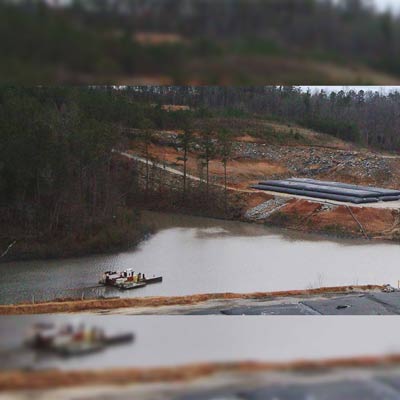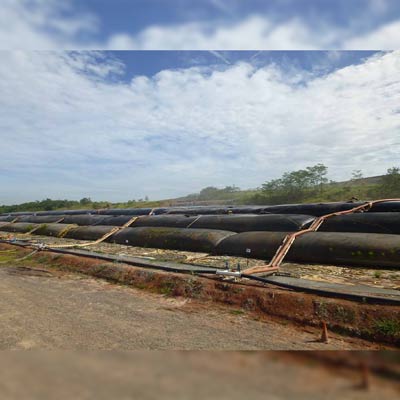




Geotube Sludge Dewatering
Geotextile Dewatering
Geotextile Geotube sludge dewatering is an important part of removing sediment, debris, and other material from the bottom of lakes, rivers, harbors, marinas. Our specially engineered textile keep fine solids inside the tube or bag, while still allowing water to flow through the durable fabric. Geotextile dewatering is often used in Waste Water Treatment Plants (WWTP's), agricultural ponds, for dredging, and coastal breakwater stabilization. Cities and counties can stay in compliance while sludge dewatering with our high volume, low cost sludge dewatering solution. Speak with one of our specialists to find out more about our available sizes to meet your site needs.
Our friendly staff is here to help you get the exact product you need!
Call Us! 1-863-261-8388or Contact us for additional information.
Geotube Sludge Dewatering Features
- Fabric: High Strength Geotextile
- Length: up to 200 ft.
- Circumference: up to 120 ft.
- Effectively Filters out Sludge, Silt, Sediment, and Waste
- Easy Removal and Disposal of Solids
- Reliable in All Weather Conditions
Geotube Sludge Dewatering Benefits
- Designed for Large or Small Sludge Dewatering Projects
- High Strength Woven Geotextile Fabrics
- Large Sizes Available
- Cost Effective and Low Maintenance
- Reduces Risks in Operational Safety
- Efficient, Versatile and Environmental Friendly
Geotube Sludge Dewatering Details
Our geotube sludge dewatering solution is specially engineered to allow large amounts of sludge and silt to be removed. Geotextile dewatering tubes are the largest dewatering product that we offer. These prefabricated tubes are created with high-strength, quality-seaming to give you an efficient and environmentally friendly solution for your dewatering applications. Designed to help you contain and dewater sludge in excess of 50%, our sludge dewatering tubes are make the process more cost-effective than belt presses or other methods of dewatering. Our sludge dewatering tubes are available in a variety of sizes for large-scale or smaller applications.
Geotextile sludge tubes work best when filled to 85% capacity with sludge and sediment, then allowed to consolidate. Once consolidation has taken place, geotubes are refilled and the cycle continues until the solids reach 85% capacity. When you leave dewatering tubes in place for extended periods. You achieve the best results. After the sludge removal process is complete, you can then remove and transport to an off-site location or used as fill or compost.
Geotube Sludge Dewatering Specifications
| Property | Value | Additional Notes |
|---|---|---|
| Length | 22', 50', 57', and 100' | Other Lengths by Special Order |
| Circumference | 22.5', 30', 45', 60', 120' | - |
| Filling Port Spacing | 1 - 3 ports | Average One Port Every 50' of Length |
Geotube Sludge Dewatering Capacity
| Size Per Tube (Circumference) | Tube Volume(Cy/Tube) Silts & Organics | Tube Volume(Cy/Tube) Sand & Minerals |
|---|---|---|
| 22.5 ft. | 20 - 25 | 20 - 25 |
| 30 ft. | 99 | 85 |
| 45 ft. | 204 | 172 |
| 45 ft. | 367 | 309 |
| 60 ft. | 553 | 464 |
| 120 ft. | 1460 | 1185 |
Geotube Sludge Dewatering Applications
With its large capacity and high strength, geotube sludge dewatering is a great solution for removing silt or sediment from the bottom of rivers, lakes or other water bodies. Our specially engineered geotextile dewatering tubes effectively contain even hazardous materials, reducing volume and saving you thousands in disposal costs.
Geotube sludge tubes are perfect for filtering the sludge and sediment from waterways. Our geotextile sludge tubes are used in marinas and other bodies of water to improve navigation and make waterways more accessible for ships and vessels. It also helps prevents flooding.
These geotextile dewatering tubes are also used to prevent beach erosion as a breakwater along beaches and coastlines. Interrupting the force of the waves prevents beaches from eroding. The dewatering tube is filled with sand and takes the impact of the wave. preventing it from washing the beach sand out to sea.
See our Geotextile Dewatering Tubes (pdf) for more information.
Geotube Sludge Dewatering Frequently Asked Questions
When using sludge tubes, you should consider using polymer to treat the sludge. The correct use of a polymer can reduce the total time required for your project and provide savings on your sludge tube system. Geotube sludge dewatering needs to be carefully monitored during the tube filling operation.
Once your sludge tube is in place, you should leave tubes to dewater over an extended period for best volume reduction. Dewatering tubes are filled and refilled again with sludge until the capacity of 85% consolidated solids is reached. Once your sludge is consolidated, you can truck consolidated material to an off-site location for disposal or used as fill or compost.




